
Farkira and Brian Chankin at Farkira's studio
On one fateful day in 2011, a friend walked into Brian Chankin’s Chicago video shop and showed him a copy of the book Ghanavision: Hand-Painted Film Posters from Ghana. He had never seen anything like it, and this brief encounter came to redefine his life’s work. The shop was called Odd Obsession Movies, and this obsession began to shift towards another equally cinematic realm.
Brian inherited his father’s love of action and horror films and, in the mid to late 1980s, he started recording films from TV. This became a collection of more than 20,000 VHS tapes and, latterly, DVDs. He would also dub tapes by connecting two VCRs, and in the early 2000s he started selling them at Odd Obsession Movies in Chicago.
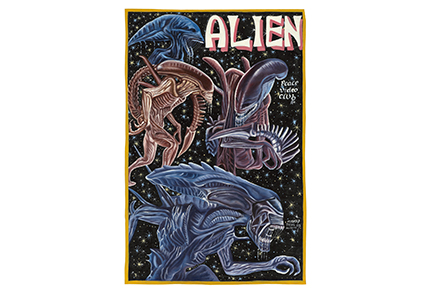
Alien by Magasco
Meanwhile, in West Africa, the relatively new technology of VHS cassettes was being put to another use: the ‘Ghanaian Mobile Cinema’. These video clubs saw entrepreneurs travelling through rural Ghana with a TV, VCR, generator, and some videos. They showed the films in make-shift screening areas, bringing something of the big screen to small villages with little or no electricity.
Due to copy-blocking technology on videos for bigger budget Hollywood productions, the films shown in these Ghanaian Mobile Cinemas were lower-budget features, especially straight-to-video action movies. Other genres were also popular due to their availability. These included Hong Kong martial arts films, Bollywood productions, and those being made more locally in Ghana (Ghallywood) and Nigeria (Nollywood).
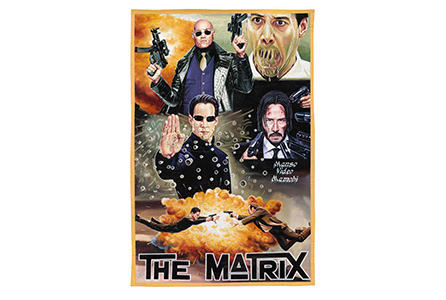
The Matrix by C.A. Wisely
The competition between the Ghanaian Mobile Cinemas led to them advertising their screenings with posters commissioned from local artists. These were typically painted on flour sacks sewn together to create a canvas, and they would travel with the video club from village to village.
The posters would typically be somewhat disconnected from the content of the films, as the artists often hadn’t seen them and cover artwork wasn’t available on the dubbed VHS tapes. The video club owner would outline what was to be included on the poster, with the objective of catching the eye of potential patrons and selling tickets, rather than any strict adherence to truth in advertising.
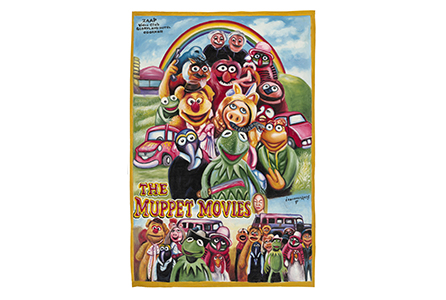
The Muppets by Leonardo
The posters were not copied, they weren’t perfect, and they may not have made sense, but, as Brian puts it: “that’s less important than the call and response created by the artwork, and its unique ability to cause the viewer to ask more questions than the artist or video club might have answers to”.
Back in Chicago, Brian was running Odd Obsession Movies, providing access to films that were difficult or impossible to find in Chicago, or indeed the USA. One day in 2011, his friend walked in with the Ghanavision book, and it was a moment he’s never forgotten: “I’d never seen anything like them! I was both confused and enlightened in the same breath.
"Everything was over the top: tons of guns, snakes, skulls, demons. Everything somehow made sense in not making sense; even though many of the titles I already knew, something was definitely off with the interpretation, which of course fascinated me more.”
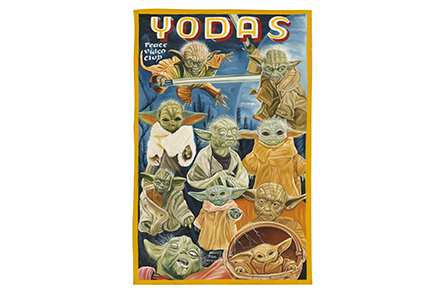
Yodas by Magasco
Brian was keen to learn more about the posters, and found a website with photos of paintings for sale. The site was run by Robert Kofi in Accra and, soon after making contact, a shipment of paintings were on their way to Chicago. What Brian didn’t know at this stage was that Kofi had worked in the mobile cinema game in the 1990s, and knew many of the poster artists from that time.
After the posters arrived, Brian put them up in the video shop and, sure enough, they caught the attention of customers. Before long, they were being offered for sale, and then the floodgates opened when Kofi confirmed that new posters could be painted on commission.
Deadly Prey Gallery
Initially working with just a handful of artists, Brian and Robert’s partnership quickly expanded to a roster of ten. Brian likens Kofi’s role to that of the former video club operators: briefing the artists, and making the creative magic happen on the ground in Ghana. It was a win-win for all involved as Brian sought out new customers, and the painters earned more from these commissions than their regular sign and artistic work.
The team quickly had a viable business on their hands, which eventually led to Brian closing Odd Obsession Movies to focus on what they named Deadly Prey Gallery. (Deadly Prey is a low-budget action film. It’s something of a cult classic in American film circles.
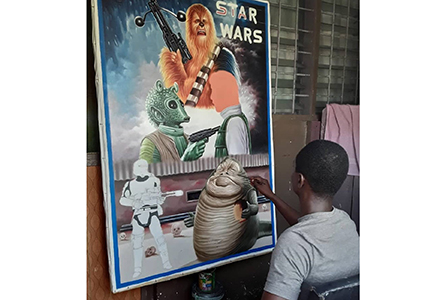
Mr. Nana Agyq painting a poster for Star Wars
However, it was a ‘blockbuster’ for the Ghanaian Mobile Cinemas, and a favourite of both Brian and Kofi.) Things accelerated even further when they expanded into prints, t-shirts, and other merchandise. These allow customers with smaller budgets to buy a piece of this unique artform, with all the profits going directly to the relevant artists.
At its core, Deadly Prey Gallery exists to promote and sustain the work of Ghanaian artists by commissioning new work and merchandising it for their benefit. The narrative that previously surrounded the film posters was one of scarcity, and it is true that original paintings from the heyday of the video clubs are relatively rare.
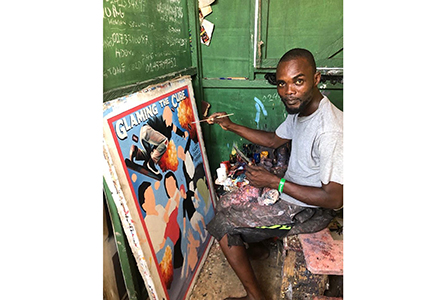
Salvation working on a poster for Gleaming The Cube
However, as Brian points out, “a myth was perpetuated that the artists somehow faded into obscurity”. This benefited the collectors and dealers, but only disenfranchised the artists themselves.
The reality is that many of these artists continued to work long after the demise of the video clubs. Deadly Prey Gallery has once again given them a canvas to flex this particular creative muscle, bringing back an artform and putting it into the hands of thousands around the world.
Sam Roberts is the editor and publisher of BLAG (Better Letters Magazine), the world's only print and online publication dedicated to sign painting.
He has written numerous books and articles on the craft and its history, and first became interested in the topic via the fading ‘ghost’ signs around London.
SignLink subscribers can sign up with a special discount to the publication via bl.ag/signlink.
Find more about Roberts and his work via:
Tags: